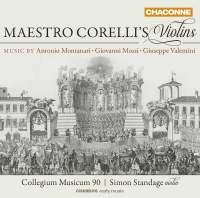Texte paru dans: / Appeared in:
CHANDOS |
|
|
Outil de traduction ~ (Très approximatif) |
|
|
Reviewer:
Barry Brenesal The title of this album, Maestro Corelli’s Violins, refers to Easter Sunday in 1708, when Handel’s La Resurrezione was premiered in Rome. Corelli conducted; and among those he hired for his 39 strings were the composer-violinists Giuseppe Valentini, Giovanni Mossi, and Antonio Montanari. This recording supplies us with one, two, and three concertos by them, respectively.
Montanari (1676–1737) was celebrated in his own day and feted by Rome’s wealthy and powerful elite, taking over leadership of Corelli’s celebrated string orchestra upon the latter’s death. He avoided publication, however, doling out score parts for rehearsal or performance and carefully collecting them all afterwards. As a result, his music never established itself throughout the Italian States, much less abroad. A single surviving copy of a corrupt, pirated edition of eight concertos (passed off in Amsterdam by Michel-Charles La Cène as Montanari’s opus 1) survives, and has been gaining attention. Very little is currently known of Mossi (c. 1680–1742) for certain, save that he was a respected violinist and composer in Rome around the turn of the 18th century. He may have been a Corelli pupil, as some assert, but there is no contemporary evidence for this. Mossi was, at least for a while, patronized by the wealthy Odescalchi clan, and was linked at one more time in the late 1720s and early 1730s with Montanari, as musicians in productions given by the artistically minded Cardinal Pietro Ottoboni.
Giuseppe Valentini (1681–1753), though represented by only one concerto, is the most interesting of this album’s composers. He was yet another musician who may have studied with Corelli, and whose career is difficult to trace. His heavily chromatic and contrapuntally adept concertos are once again beginning to attract attention in the modern concert hall and on records.
The performances are amiable and discreet. Fast tempos are alert, but rarely urgent. Slow tempos occasionally are sometimes faster and more prosaic-sounding than I would like—for instance, in the adagio movement of Montanari’s op. 1/7. On the other hand, Collegium Musicum 90 hits precisely the right combination of momentum and lingering to bring out the detail and harmonic beauties of the adagio to Mossi’s op. 4/12.
Dynamic and agogic accents are both decorous, perhaps too much so at times. The intelligent liner notes refer to Valentini’s music as “quirky, harmonically adventurous, and can occasionally be long-winded,” but I only noted this in the first allegro of his op. 1/6, and only on this recording. That of Chiara Banchini and the Ensemble 415 (Zig-Zag 316; Fanfare 36:5) applies more strongly contrasting tempos, a more flexible approach to phrasing, and sharply accented rhythms. It never feels long-winded.
While on the Valentini, there’s a passage in the work’s third movement where what has been essentially a dialogue of two violins in harmonic figurations explodes in a lengthy contrapuntal flurry of 16th notes given to the cello. (It’s a concerto grosso whose concertino consists of two violins and a cello, but the cello’s contribution has been modest up until that point.) Banchini makes certain the cello’s eruption takes center stage, but on the current release, it’s almost impossible to hear the cello as it solos far in the background, while the violins continue to occupy center stage with less interesting material. Critical balance is missing.
The performances are, however, technically expert. Simon Standage himself is in his mid-70s, but if his dexterity isn’t always quite what it was in the older recordings I have, he still plays with the skill of a younger man, and with an experience and insight that cannot be discounted. He and his Collegium Musicum 90, which has been in existence for a quarter of a century, perform with a sleekly beautiful tone that especially comes to the fore in the disc’s slower movements.
(The album’s liner notes make the point that Le Cène’s Montanari edition tries to convert the Fourth Concerto’s implementation of concerto grosso textures—two solo violins, one solo cello—into a solo violin concerto, and that they used instead surviving manuscript sources for greater accuracy. Good for them. It was bad enough when music publishers issued pirated editions of works, never paying a cent to composers, but then went on to edit them without consultation. That was not just theft, but a form of defacement that drew bitter comment even when it was considered as much a part of the cultural landscape as Latin theses and the Fraktur typeface.)
In short,
this is a release that fans of Collegium Musicum 90 should greatly enjoy,
and a good indication of its current strengths. | |
|
Support us financially by purchasing this disc from eiher one of these suppliers. Un achat via l'un ou l'autre des fournisseurs proposés contribue à défrayer les coûts d'exploitation de ce site. |
|
|
|
|
|
Cliquez l'un ou l'autre
bouton pour découvrir bien d'autres critiques de CD |
|




